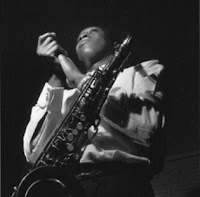Hank Mobley Quartet
Released - 1955
Recording and Session Information
Van Gelder Studio, Hackensack, NJ, March 27, 1955
Hank Mobley, tenor sax; Horace Silver, piano; Doug Watkins, bass; Art Blakey, drums.
tk.3 Walkin' The Fence
tk.5 Avila & Tequila
tk.8 Hank's Pranks
tk.10 Just Coolin'
tk.12 My Sin
tk.14 Love For Sale
Session Photos
Photos: Francis Wolff
Track Listing
| Side One | ||
| Title | Author | Recording Date |
| Hank's Prank | Hank Mobley | March 27 1955 |
| My Sin | Hank Mobley | March 27 1955 |
| Avila and Tequila | Hank Mobley | March 27 1955 |
| Side Two | ||
| Walkin' The Fence | Hank Mobley | March 27 1955 |
| Love For Sale | Cole Porter | March 27 1955 |
| Just Coolin' | Hank Mobley | March 27 1955 |
Liner Notes
Hank Mobley, tenor sax; Horace Silver, piano; Doug Watkins, bass; Art Blakey, drums.
HANK MOBLEY may never "make" the cover of Time magazine. His name may never be on the lips of the "chi-chi" set, and it is doubtful to assume that he will switch to Cronkhite Whiskey and become a Man of Distinction. But from his work on this record, Hank Mobley certainly should be recognized by the general public, (as he is now by those "on the jazz scene") as one of the most important of today's young tenor saxophonists.
Hank Mobley was born on July 7, 1930. He was brought up in Elizabeth, N. J. His grandmother played piano and organ, and his uncle played piano, so when he was small he had a liberal amount of piano lessons. When Hank was 16, an illness kept him in the house for several months. His uncle had the idea to get him an instrument to help occupy his time, and bought Hank a saxophone. Later, Hank tried to enter a music school in Newark, but couldn't, because he was not a resident. With his grandmother's help, he got books on music, and studied theory and harmony at home. Two years later, when he was 19, Hank started to play with local bands, and then went on the road with Paul Gayton's six piece rhythm and blues band. He stayed with Gayton's band for 9 months, and then worked around Newark with Lester Young and Dexter Gordon. In 1951 he joined Max Roach. He played on and off with Max until 1953, when Dizzy Gillespie hired him to play with his band. It was during the association with Max and Dizzy that Hank started cultivating his own style. In 1954 he joined The Messengers, (Horace Silver, Art Blakey, Doug Watkins, and Kenny Dorham) with whom he was heard on previous Blue Note LPs (5058, 5062).
The set opens with a fast-driving original titled Hank's Prank. After a short intro, Hank starts moving at a quick pace. His fluid horn rides effortlessly through a series of crisp and effective phrases which keep you interested all the way.
My Sin, a slow ballad written by Mobley, is in a dreamy, pensive mood. Hank delivers the message of the mood with warmth and sincerity, and Horace Silver takes a very pretty piano solo near the end of the Avila and Tequila, another original by Mobley, is a mixture of exciting Latin and jazz rhythms. Hank's buoyant horn swings throughout, while he shows to good advantage his wide scope of ideas. The side is further embellished by some tasty and intricate drumming by Art Blakey.
Walkin' The Fence opens with a Horace Silver piano intro which sounds like a musical cartoon of Count Basie for four bars. It then goes into a medium blues, in which Hank, Horace and Art very effectively take turns in feeding each other fresh ideas. Doug Watkins supplies a groovy beat throughout.
Love For Sale, the Cole Porter standard, is an excellent showcase of Hank Mobley's artistry, and his mastery of his instrument. The tune is played at quite a rapid pace, yet when Hank takes off on an improvisation his ideas are always exciting, but never out of control.
The final side of the set, Just Coolin', is an item set in a minor mood. A bit of stop and go rhythm is included for flavoring. Hank, changing tempos several times, really "swings" throughout.
The rhythm section of Horace Silver, Doug Watkins and Art Blakey can be highly lauded for its work on this album. They are cohesive and forceful, yet never overemphatic.
Of late there has been a great deal of discussion concerning "What Can Be Done To Improve Modern Jazz", "Where Is It Going", and "What Can We Do To Make It Go The Right Way?" Some critics say it lies in structure, some say fuller arrangements, and still others think that a closer association with classical music is needed. However, I'll go along with the theory that the future of modern jazz lies completely in the facility and imagination of the individual soloist. Take the great tenormen, Coleman Hawkins, Lester Young and Stan Getz. They all possessed these qualities, and they all have been monumental figures in modern jazz. They all worked with the greatest bands of their era. So did Hank Mobley. They all learned from the leaders of their era. So did Hank Mobley. As a teenager, he spent his allowance money, and most of his spare time in digging the "Bird" and "Bud".
Yes, Hank Mobley has facility, imagination, intelligence and background. He has improved consistently to the point where he has become a leader in modern school of tenors. Whenever The Messengers play, Art Blakey invariably introduces Hank Mobley as "the baby of the group", but this baby "swings", he is growing up.
—EUGENE ST. JEAN
Cover Design by HERMANSADER/MILES
Photo by FRANCIS WOLFF








No comments:
Post a Comment